making 3D glasses for a Silicon Graphics
there’s an add-on to this project as well: 3D glasses for any VESA-compliant stereo port
Ever since I got myself an Octane, I’ve got a renewed interest in everything Silicon Graphics. And with that, my old (imaginary) list of things-to-do with such a machine has been dusted off too. One of those things was making some 3D shutter glasses (cheap). And even though I’m tinkering with SGIs for years already, I never took the time to build some stereographic glasses myself, a project which has been online for years already and I’ve been wanting to do ever since I read it. And now it was time to actually make my own pair. ^_^
One of the official possibilities for these kind of machines is connecting CrystalEyes StereoGraphic glasses to them. Most (if not all) graphic options for SGIs have some kind of stereo capability. Now even though a lot of the SGI related goodies have become cheap (on eBay for instance), I couldn’t find the glasses plus the transmitter anywhere. I could find glasses separately, but that would still mean I have to make a transmitter and well, I had these parts around for ages already so I gave it a go to finally connect cheap shutter glasses (instead of the CrystalEyes ones) to the StereoView Port of one of my SGIs.
The theory behind stereoscopy in general is that your left eye needs a dfferent image then your right eye to get the illusion of depth. Now there are several ways of doing this, these shutter glasses are just one of them.
from Wikipedia:
LCD shutter glasses are glasses used in conjunction with computers or TV screens to create the illusion of a three dimensional image, an example of stereoscopy. Glass containing liquid crystal and a polarizing filter has the property that it becomes dark when voltage is applied, but otherwise is transparent. A pair of eyeglasses can be made using this material and connected to a computer video card. The video card alternately darkens over one eye, and then the other, in synchronization with the refresh rate of the monitor, while the monitor alternately displays different perspectives for each eye.
When you’re into the SGI hobbyist scene, you know this is possible for a long time already, there’s nothing new here. The reason that I post this is that I hope to inspire some people to grab an SGI cheap somewhere and tinker around with it. I mean, these still are magical machines and you can pick one up (depends on the model) for near to nothing and if you have no budget at all, even 8-bit graphics on an Indy has stereo capability (although it’s recommendable to get a quicker model with better graphics).
Like I said, there’s nothing new here and when you go google for this, you probably end up at M.C.D. Roos’ (old) site where he explains how you can connect LCD shutter glasses to an Indy (or any other SGI for that matter).
Now I happened to have the exact same Asus LCD shutter glasses as those mentioned in M.C.D. Roos’ original project page. Asus bundled those ages ago with V3800 TNT2 Ultra Deluxe (don’t you just love the name?) video cards.
You should be able to find a pair yourself cheap. Make sure you look for *LCD* shutter glasses otherwise you’ll end up looking like Paris Hilton (or Kanye West) and even though you will look impressive, you won’t be seeing any 3D soon (other than the real world).

image courtesy: monikapolitan.com, where you can also buy these
click to enlarge
If you really can’t find LCD shutter glasses anywhere, at Razor 3D online you can buy some new ones.
the actual project
The whole point of this project is getting a connection from the StereoView Port from an SGI (and there are several ports used on different graphic options) to a pair of plain and simple LCD shutter glasses with only three connections (ground, left eye, right eye). Whatever glasses you have found, I guess you will be able to bring them down to those three connections. All my SGIs luckily have the same connection and that’s the three pin DIN connection, but you could also find for instance a 9 pin port on older Octanes (with SSE graphics for instance) or certain Indigo2s (with (High) Impact graphics). I guess you can adapt this circuit fairly easy to a 9-pin StereoView Port although I found someone who also made a much more complicated circuit for achieving this (and to be honest, I’m not sure why that would be needed).
Some pinouts:
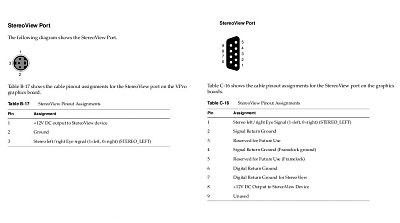
you can find these in the workstation manual of your SGI
click to enlarge
For details on the circuit I suggest you read Michiel Roos’ original page, what results is a fairly simple circuit:

courtesy: M.C.D. Roos
click to enlarge
I just followed that circuit and bought the electronics parts needed to make it. For around $10 you should be done.
Now I bought too much parts(...), in the end I only needed one LM324 because one LM324 consists of four amplifiers and we need only two. In the circuit, for the second LM324 you can use pin 14, 13 and 12 instead of 1, 2 and 3.
For the board itself, on which I could mount all this, I used some experimental print (I’m not sure what to call this). And to make room for the LM324, I scraped away copper with a sharp knife. (if you look carefully, you can see the pins in the right picture).
First I soldered pin 4 (+12V) and 11 (ground) and to be honest, from there on, I didn’t have a plan, so I just started to put the components in place and used some common sense to get it all right. Make sure you use a multi-meter to check for shortcuts and such!
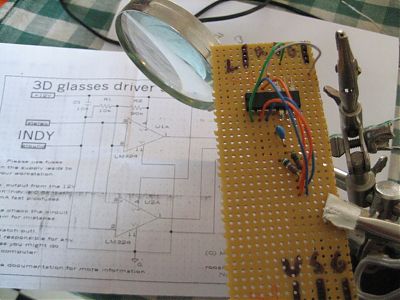
you can see I used a print-out while putting this together
click to enlarge
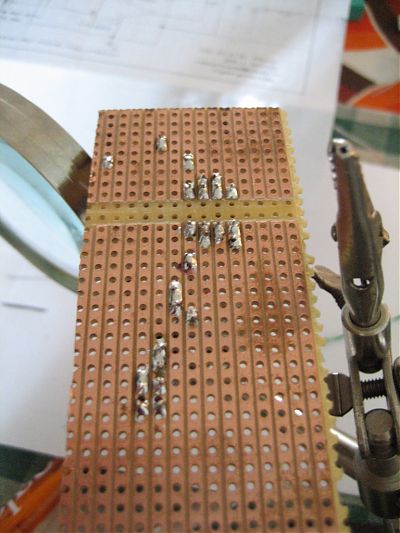
the back side
click to enlarge
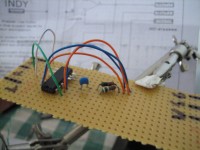
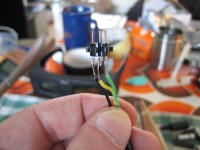
on the left the circuit in progress and on the right the three pin mini-DIN
click to enlarge
testing the glasses
Well, of course this wasn’t going to work in the first run and indeed, it didn’t. ^_^
First, I need a better monitor (capable of 1280×1024 at 100Hz, which will give 50Hz per eye) for my Octane, so for testing these glasses, I used my Indigo2 and luckily, that worked.
(My Indigo2 with Extreme graphics runs stereo in 1280×492 @ 120Hz)
As a test application to see if these glasses really work, I remembered a game, Hacknoid. But, as it seems, the old site with that game is no longer online and so I used the Wayback Machine to get to that page and that worked!
from that page:
Download the SGI version for free!
The original version of Hacknoid, which runs on SGI platforms only, is still available! This is the same game that won the IndyZone3 competition in 1995. The game and documentation are available in two separate packages, either as a compressed (.Z) or gzipped (.gz) version. Download the one you need! Requires IRIX 5.3 or higher.
NOTE: THESE FILES WILL NOT RUN UNDER MICROSOFT WINDOWS! Don’t waste your time downloading them if you do not have an SGI system!
The game:
- gzipped (.gz) version (1.8 MB)
- compressed (.Z) version (2.4 MB)
The documentation:
- gzipped (.gz) documentation (300 KB)
- compressed (.Z) documentation (514 KB )
PLEASE NOTE: no support will be given for the SGI version.
Those links should work (thank you, archive.org!), if not, let me know (in the comments) and I’ll put them online somewhere.
Anyway, with Hacknoid and my Indigo2 I was able to test these glasses and it seemed I forgot one connection of the circuit (...I forgot to ground the fuse, which gave some strange results) but after I fixed that, the glasses worked!
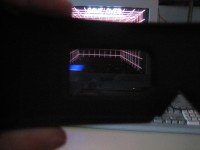
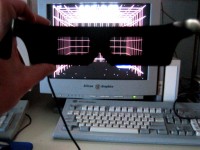
if you look carefully, you can see double lines on the monitor while there are single lines viewed through the glasses
click to enlarge
All this is quite some work just to play a game from 1995, even though Hacknoid is a fun game and it’s quite hard to get the paddle at the same depth as the ball.
Still, the idea is I can connect these to my Octane one day and use some more applications with this and I’m pretty sure I will. (if someone sees me biking around with an old 24” CRT, now you know why).
Otherwise I’ll probably find some more (fun) uses on my Indigo2 with these.
there’s an add-on to this project as well: 3D glasses for any VESA-compliant stereo port
DIY trackback
MAKE:blog
Hack a Day
you can find all of my projects overhere
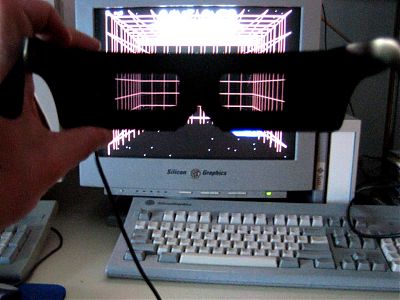
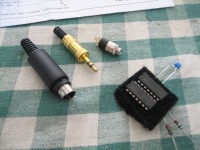
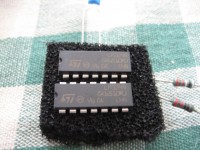
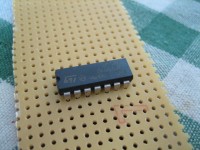
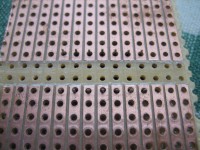
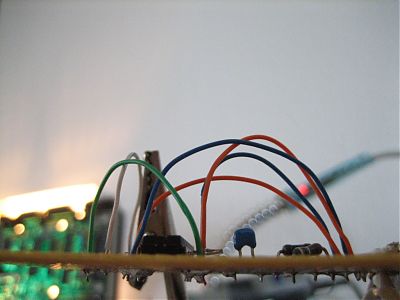




smile, you’re on hackaday: http://www.hackaday.com/2008/06/30/3d-glasses-for-an-sgi/
*smile*
...aahhh brings back memories. Nice work!
I like SGIs, but some people might like to take advantage of the glut of Nvidia Quadro FX cards (and similar) on ebay these days (also a cheap way to get in stereo graphics, but without the nostalgia unfortunately). The problem is always getting hold of a decent CRT though!
> I like SGIs, but some people might like to take advantage of the glut of Nvidia Quadro FX cards
Yes indeed, Quadro cards and also ATI’s FireGL cards have a three-pin DIN similar of what I used here. I don’t see why these glasses with this circuit in between (and the same connector to the graphics card even) wouldn’t work, but I have to test that first.
I happen to have an old AGP Pro ATI Fire GL 4 and I’m gonna test these glasses on that too.
> The problem is always getting hold of a decent CRT though!
Well, with a Quadro and/or a FireGL you will get more stereo resolutions (with a bigger chance there’s at least one that your CRT will accept) than what I got on my V6 graphics. There I only got one (1280×1024 @ 100Hz).
By the way, a (imho) nice fact from Wikipedia:
“Nvidia intended the Quadro card as a successor to the SGI VPro Graphics pipeline (the so-called “Pipeline on a chip” concept)”
http://en.wikipedia.org/wiki/Quadro
I read an article that said LCD shtter glasses that stobe in a range of 4-6 Hz with a short dwell may significantly relieve motion sickness.
My daughter-in-law suffers from motion sickness and I was wondering if the LCD shutter glasses you speak of can be set up to have an adjustable rate and dwell time and run independently (i.e.: no computer or other bulky external device besides a battery). If so, would you send an email to me with your suggestions?
Thank you,
Steve Conner
Dear Sir, I am Debraj from INDIA. I want to purchase 30 pcs. 3d wired lcd shutter glasses and some 3d accessories. Please send me photo of 3d wired shutter glass with price. After getting the e-mail please contact with me to my e-mail ID.
Regards Debraj3D Wired Glasses, Avatar Reald glasses, Anachrome glasses and more 3d products available. Check at : www.chandnimarket.com & www.3dmegashop.com
Looks Really Great, Keep it up.
nice,perfect article,Thanks for share
I live in the UK and it’s only in the last 6 months that the cost of these glasses have been greatly reduced.